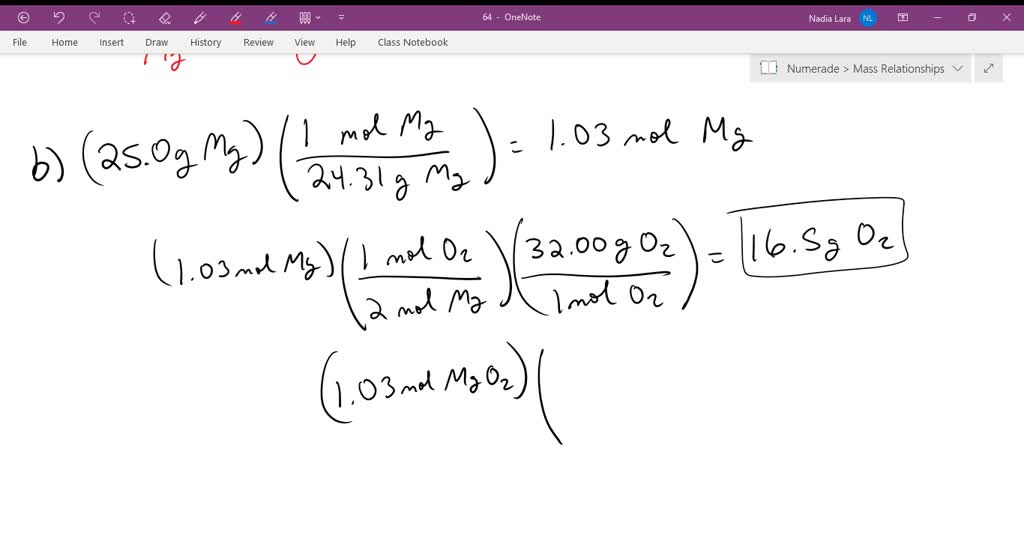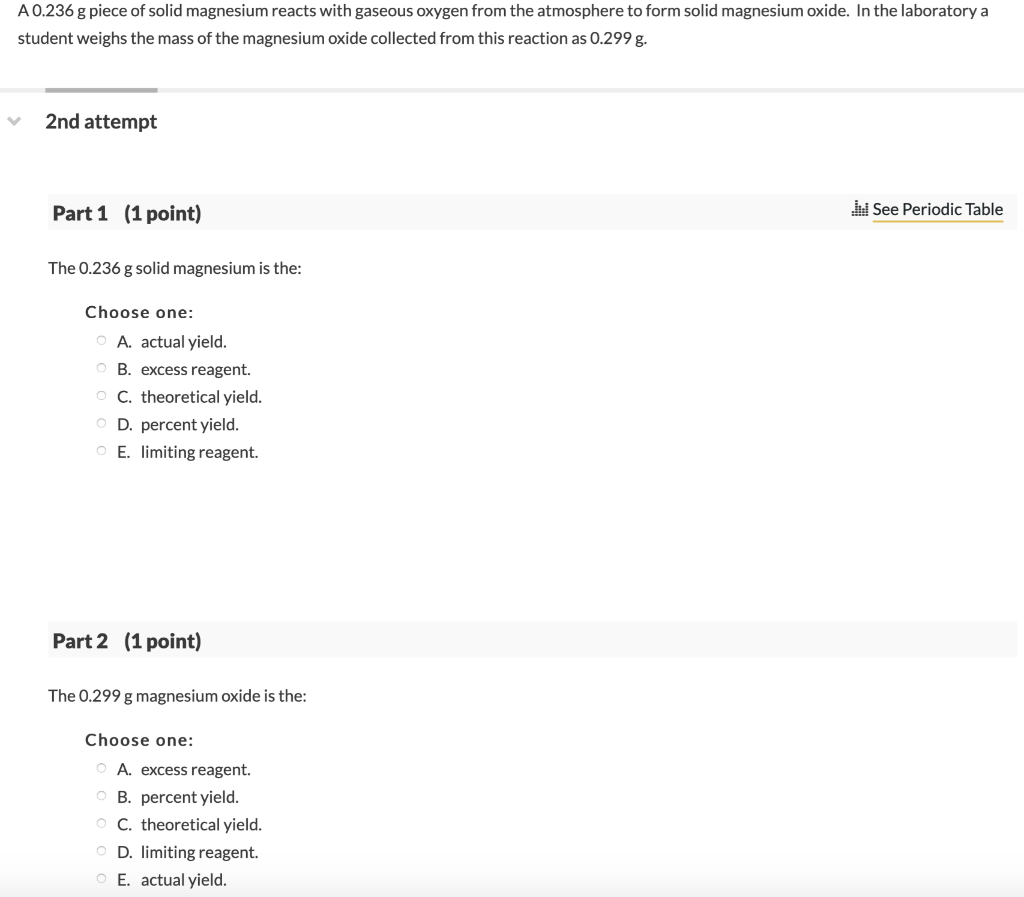Magnesium Reacts With Oxygen To Form
Magnesium Reacts With Oxygen To Form - From these two masses, you calculate the percentage composition of magnesium oxide. We have been given that mg reacts with oxygen in the fixed ratio of 3 : Web answer (1 of 4): A short video that shows magnesium reacting with oxygen. After the magnesium sample has reacted completely, you determine the mass of magnesium oxide product. Magnesium reacts with oxygen to create magnesium oxide. 2mg(s) + o2(g) → 2mgo(s) you know that 10.0 g of magnesium take part in this reaction and that 16.6 g of magnesium oxide are produced. Web detailed solution download solution pdf concept when magnesium is heated it reacts with oxygen vigorously producing light and heat. The reaction products are clear afterwards, and it adds a lot of light. 2mg (s) + o 2 (g) → 2mgo (s) expert solution trending now this is a popular solution!
Web magnesium reacts with oxygen to form magnesium oxide , mgo. #2mg(s) + o_2(g) => 2mgo(s)# remember that combustion reactions occur when a species reacts with #o_2#, oxygen gas to release heat and produce a flame. How many grams are needed to obtain 1.5 mole of magnesium carbonate? Web potassium + oxygen potassium oxide. Web magnesium has a charge of 2+, while oxygen has a charge of 2−. Web the reaction between magnesium and oxygen. Web magnesium reacts explosively with oxygen to form magnesium oxide. After the magnesium sample has reacted completely, you determine the mass of magnesium oxide product. Web magnesium is a group ii metal, and therefore has two electrons in it's highest energy level (or outermost electron shell). Web when magnesium reacts with oxygen, it produces light bright enough to blind you temporarily.
Web the reaction between magnesium and oxygen. 2m g(s)+o2(g) → 2m go. We have been given that mg reacts with oxygen in the fixed ratio of 3 : 2mg (s) + o 2 (g) → 2mgo (s) expert solution trending now this is a popular solution! 2mg(s) + o 2 (g) → 2mgo(s) Ncert 10th 1st chapter, experiment 1.1the video demonstrates how magnesium burns in air to form a white powder called magnesium. Web detailed solution download solution pdf concept when magnesium is heated it reacts with oxygen vigorously producing light and heat. Magnesium combines with oxygen to form magnesium oxide. 4k(s) + o 2 (g) 2k 2 o(s) magnesium reacts readily in air burning with a white light. Web magnesium’s reaction with oxygen is an interesting oxidation/reduction reaction because it shows the burning of a metal.
Magnesium ribbon reacts with oxygen gas to form magnesium oxide. YouTube
Electronegative values are based how strongly an element can pull electron density towards it and electropostive values are based on how likely the element is to let electron density go. Web magnesium reacts with oxygen to form magnesium oxide, mgo. Which is not true of this reaction? Just because you are heating something to get it to react does not.
Reaction of Magnesium and Oxygen YouTube
A magnesium atom will lose 2 electrons to form a stable 2 + ion. The two electrons donated from one magnesium atom are taken up by an oxygen atom. How many moles of oxygen molecules are needed to produce 10.0 moles of magnesium oxide ? Web in your case, magnesium metal and oxygen gas are the reactants and magnesium oxide.
Magnesium reacts with hydrochloric acid Stock Image C028/0732
Web magnesium will react with oxygen to become magnesium oxide mg + o2 = mgo (s) balanced, this is 2 mg + o2 = 2 mgo if there is water around, the mgo will react with that to become mg (oh)2. If 10.57 g of magnesium reacts completely with 6.96 g of oxygen, what is the percent by mass of.
Reaction of Magnesium with Oxygen Gas (Burning Magnesium in Air) YouTube
#2mg(s) + o_2(g) => 2mgo(s)# remember that combustion reactions occur when a species reacts with #o_2#, oxygen gas to release heat and produce a flame. Electronegative values are based how strongly an element can pull electron density towards it and electropostive values are based on how likely the element is to let electron density go. Oxygen is in group 6.
SOLVEDMagnesium metal burns in oxygen to form magnesium oxide, MgO. (a
We have been given that mg reacts with oxygen in the fixed ratio of 3 : So, 24g of mg requires =. Magnesium + oxygen magnesium oxide. Just because you are heating something to get it to react does not mean there is a net flow of heat from the surrounding into the reaction. Thus, magnesium reacts with oxygen to.
Magnesium Oxide Uses, Benefits, Dosage, Side Effects
Thus, magnesium reacts with oxygen to form magnesium oxide. Magne oxide is the primary product, but a magnesium nitride is also produced. Web when magnesium reacts with oxygen, it produces light bright enough to blind you temporarily. Web answer (1 of 4): Electronegative values are based how strongly an element can pull electron density towards it and electropostive values are.
magnesium reacts with oxygen to form magnesium oxide equation
So, 24g of mg requires, 16g of oxygen to combine. 304k views 12 years ago. Electronegative values are based how strongly an element can pull electron density towards it and electropostive values are based on how likely the element is to let electron density go. The mass of magnesium oxide produced equals the mass of magnesium consumed plus the mass.
Simple Composition Reaction of magnesium and oxygen YouTube
Web magnesium metal reacts with the oxygen (o2) of the air to form magnesium oxide. Web magnesium reacts with oxygen to form magnesium oxide , mgo. We have been given that mg reacts with oxygen in the fixed ratio of 3 : Mg + o2 ® magnesium oxide. After the magnesium sample has reacted completely, you determine the mass of.
Write the chemical equation describing the complete
Thus, magnesium reacts with oxygen to form magnesium oxide. Web magnesium will react with oxygen to become magnesium oxide mg + o2 = mgo (s) balanced, this is 2 mg + o2 = 2 mgo if there is water around, the mgo will react with that to become mg (oh)2. Oxygen is a very elctronegative element, on the other hand.
"OMG Oxygen Magnesium" Poster by ivperisic Redbubble
The reaction describes the formation of a new substance. So, 24g of mg requires, 16g of oxygen to combine. 2mg(s) + o 2 (g) → 2mgo(s) Web magnesium reacts with oxygen to form magnesium oxide, mgo. After the magnesium sample has reacted completely, you determine the mass of magnesium oxide product.
Web Magnesium Reacts With Oxygen To Form Magnesium Oxide, A) Write A Balanced Chemical Equation For This Reaction.
Web magnesium will react with oxygen to become magnesium oxide mg + o2 = mgo (s) balanced, this is 2 mg + o2 = 2 mgo if there is water around, the mgo will react with that to become mg (oh)2. Web magnesium’s reaction with oxygen is an interesting oxidation/reduction reaction because it shows the burning of a metal. #2mg(s) + o_2(g) => 2mgo(s)# remember that combustion reactions occur when a species reacts with #o_2#, oxygen gas to release heat and produce a flame. Oxygen is a very elctronegative element, on the other hand magnesium is very electropositive.
The Burning Of Magnesium Metal Reacts With Oxygen Found In The Air (Oxygen Gas) To Form Magnesium Oxide.
The reaction products are clear afterwards, and it adds a lot of light. Web if magnesium reacts with oxygen to produce magnesium oxide only on the application of heat, then why isn't it categorised as an endothermic reaction? 304k views 12 years ago. Web answer (1 of 4):
2M G(S)+O2(G) → 2M Go.
Oxygen is in group 6 of the periodic table. If 10.57 g of magnesium reacts completely with 6.96 g of oxygen, what is the percent by mass of oxygen in magnesium oxide?. 2mg + o 2 → 2mgo plus heat and light mistake points when the magnesium reacts with the oxygen. Web in your case, magnesium metal and oxygen gas are the reactants and magnesium oxide is the product.
Magnesium + Oxygen Magnesium Oxide.
Magnesium is in group 2 of the periodic table. A magnesium atom will lose 2 electrons to form a stable 2 + ion. Web maybe we want to try to imagine the chemical system, which could look like this: When the reaction with oxygen occurs, these two electrons are donated by the magnesium, forming positively charged mg 2+ ions.









